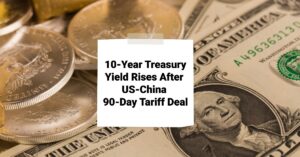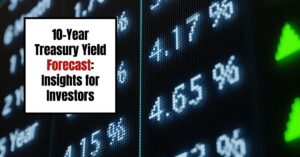The bond market reacted when the US-China 90-Day Tariff Truce was announced. This temporary break in the trade war between the world's two largest economies led investors to become a bit less scared about the future, causing them to sell off safe-haven assets like U.S. Treasury bonds. This selling pressure pushed the price of bonds down, and as you probably know, when bond prices fall, their yields – specifically the 10-year Treasury yield – go up.
How the US-China 90-Day Tariff Truce Sent 10-Year Yields Climbing
Think of it like this: when there's a lot of worry in the air about things like a potential recession caused by escalating tariffs, people want the security of government bonds, even if the return isn't huge. This increased demand pushes bond prices up and yields down. But when a bit of good news comes along, like this tariff truce, that worry eases. Investors feel more comfortable putting their money into potentially higher-growth areas, and they're less desperate for the safety of bonds. Hence, they sell bonds, prices drop, and yields rise.
This wasn't just a tiny blip either. The announcement caused a noticeable jump in the 10-year Treasury yield, reaching its highest point in about a month. To put it in numbers, we saw the yield climb to around 4.45%, a significant increase from the lower levels we saw earlier in April. This jump tells us a story about how sensitive the bond market is to the ebbs and flows of global trade tensions.
A Look Back: Tariffs and the Bond Market's Twists and Turns
This recent reaction wasn't out of the blue. We've seen this movie before, haven't we? Remember back in early April when there was news about new tariffs being slapped on Chinese goods? Initially, investors got spooked and flocked to the safety of Treasury bonds, causing yields to dip. But then, almost as quickly as they fell, yields bounced back up. This showed us that while tariff escalations can initially trigger a flight to safety (pushing yields down), they can also lead to fears of higher inflation and slower growth down the line, which can ultimately push yields higher.
It's almost like the market is constantly trying to figure out the puzzle. Is a tariff hike going to lead to a recession, making safe bonds attractive? Or will it lead to higher prices, making those fixed-income returns less appealing? The US-China 90-Day Tariff Truce news fell squarely into the “de-escalation” category. Historically, when there's a pause or a rollback of tariffs, the immediate reaction is often a sell-off in bonds, leading to higher yields. This truce basically signaled that the worst-case scenario of ever-increasing tariffs might be avoided, at least for now.
What the Experts Are Saying: A Collective Sigh of Relief (with a Pinch of Salt)
It wasn't just the numbers on the screen that told the story. Analysts and market strategists around the world had plenty to say about this 90-day tariff truce and its impact. Many pointed out that the scale of the tariff reductions was actually quite surprising. Some even used phrases like “much bigger than expected,” which highlights the sense of relief that rippled through the markets.
However, this optimism came with a healthy dose of caution. Experts reminded us that this is just a temporary pause. The underlying issues between the US and China haven't magically disappeared. As one analyst put it, it's a “long-term positive plus 90 days of uncertainty.” The tariffs are significantly lower during this truce (U.S. tariffs on some Chinese imports dropped from 145% to 30%, and China's duties on some U.S. goods fell from 125% to 10%), but the fact remains that tariffs still exist.
Here are some key takeaways from the expert commentary:
- Relief is Temporary: While the market breathed a sigh of relief, the 90-day window means the threat of renewed or even higher tariffs looms in the future.
- Uncertainty Remains: Even with the reduced tariffs, the fundamental trade disputes between the two nations are still unresolved, creating ongoing uncertainty for businesses and investors.
- Impact on Growth: While the truce is seen as positive for short-term growth by easing supply chain concerns, the lingering tariffs and potential for future escalation still pose a risk.
- Inflationary Pressures: Even with the tariff reductions, some level of tariffs remains, which will likely continue to contribute to inflationary pressures, albeit less than before.
The Fed's Perspective: Less Pressure for Rate Cuts?
The Federal Reserve also weighed in on the implications of the US-China 90-Day Tariff Truce. One Fed official noted that this development should help to ease some of the inflation that was being driven by the trade war. This good news also led to a slight shift in market expectations for future interest rate cuts. With the immediate threat of escalating tariffs diminished, the pressure on the Fed to lower rates to stimulate the economy seemed to lessen, at least in the short term.
However, it's important to remember that even with the reduced tariffs, they still exist, and a Fed Governor pointed out that a 30% tariff will still lead to higher prices and slow down the economy to some degree. So, while the truce might have pushed out expectations for rate cuts, it didn't completely eliminate them. The Fed will likely continue to monitor the situation closely, paying attention to both inflation data and economic growth indicators.
Beyond Bonds: A Ripple Effect Across Global Markets
The impact of the US-China 90-Day Tariff Truce wasn't limited to just the bond market. We saw a broader “risk-on” sentiment take hold across global markets. Stock markets in the US, Europe, and Asia generally rallied on the news. This makes sense because a de-escalation in trade tensions is seen as a positive for corporate earnings and overall economic activity.
Interestingly, the US dollar also strengthened against many other currencies. This could be because the truce was seen as particularly beneficial for the US economy in the short term. On the other hand, safe-haven assets like gold, which tend to do well when investors are worried, saw their prices fall as the immediate fear of a full-blown trade war subsided.
China's markets also reacted positively. The Chinese stock market went up, and the yuan, their currency, reached a six-month high. This reflects the fact that Chinese officials also viewed the truce as a positive development for their businesses and for global stability.
The Bigger Picture: Buying Time, Not Solving the Problem
While the US-China 90-Day Tariff Truce provided a welcome break from the escalating trade tensions, it's crucial to understand what it really represents. In my opinion, it's more of a temporary pause – a chance for both sides to come back to the negotiating table and try to find a more lasting solution. It doesn't erase the fundamental disagreements that led to the trade war in the first place.
Think about it: even with the reduced tariffs during this 90-day period, US consumers are still facing an average tariff level that's higher than it's been since the 1930s. This tells us that while the immediate pain might be lessened, the underlying cost of the trade war hasn't gone away entirely. Estimates suggest that the tariffs put in place are still expected to raise US price levels and dampen economic growth to some extent.
So, while I was as relieved as many others to see this truce, I also know that we're not out of the woods yet. The next 90 days will be crucial. Will this temporary break lead to a more permanent agreement, or will we see tensions flare up again? That's the big question mark hanging over the global economy right now, and it's something that will continue to influence the bond market and beyond.
“Secure Real Estate While Treasury Yields Climb”
As the 10-Year Treasury yield rises following the US-China tariff agreement, real estate remains a reliable hedge against market volatility and shifting bond returns.
Norada offers cash-flowing investment properties that outperform traditional fixed-income assets—ideal for building passive income in today’s rate environment.
HOT NEW LISTINGS JUST ADDED!
Talk to a Norada investment advisor today (No Obligation):
(800) 611-3060
Recommended Read:
- Interest Rate Predictions for the Next 10 Years: 2025-2035
- Will the Bond Market Panic Keep Interest Rates High in 2025?
- Interest Rate Predictions for 2025 by JP Morgan Strategists
- Interest Rate Predictions for Next 2 Years: Expert Forecast
- Fed Holds Interest Rates But Lowers Economic Forecast for 2025
- Fed Indicates No Rush to Cut Interest Rates as Policy Shifts Loom in 2025
- Fed's Powell Hints of Slow Interest Rate Cuts Amid Stubborn Inflation
- Fed Funds Rate Forecast 2025-2026: What to Expect?
- Interest Rate Predictions for 2025 and 2026 by NAR Chief
- Market Reactions: How Investors Should Prepare for Interest Rate Cut
- Interest Rate Predictions for the Next 3 Years
- Impact of Interest Rate Cut on Mortgages, Car Loans, and Your Wallet
- Interest Rate Predictions for Next 10 Years: Long-Term Outlook
- When is the Next Fed Meeting on Interest Rates?
- Interest Rate Cuts: Citi vs. JP Morgan – Who is Right on Predictions?
- More Predictions Point Towards Higher for Longer Interest Rates



